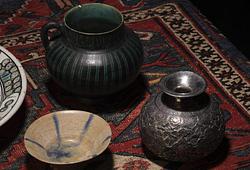Pehr Hilleström
"Tvänne Qvinnor, den ena skär skinka, den andra stöter peppar" (= Two women, one cutting ham the other grinding pepper)
Signed Hilleström and indistincly dated 1794. Canvas 60 x 47 cm. Contemporary bronzed and gilded frame.
Provenance
Eariler in the collection of Bengt Johansson, no 668.
Literature
Listed in the artists own register, catalogue no 755, "2ne Qvinnor, den ena skär skinka, den andra stöter peppar".
Gerda Cederblom, "Pehr Hilleström som kulturskildrare", I, 1927, illustrated and mentioned, no 66. (Wrongly descibed as unsigned).
More information
Pehr Hillström is considered to be the first real genre painter and depicted contemporary life in Sweden. He reproduced the Gustavian era of people in work, pleasure and celebration. All classes of society are represented in the paintings, from the elegant to the simple, the salons to the kitchen regions. He renders his models often in fabricated environments in a narrative style and according to certain conventions. Hillström is not interested in any psychological interpretation, but instead lets them express themselves with gestures and facial expressions to emphasize the anecdotal content of the image. These little genre pictures were estimated primarily by landowners and wealthy citizens, but also of the nobility. In these everyday scenes one can see similarities with the French artist Jean-Baptiste-Simeon Chardin's genre pictures.
The young officer son began his artistic training in Stockholm with Johan Philip Korn and Guillaume Taraval at the predecessoro f The Royal Academy of Fine Arts (Kongl. Ritarakademin). With the help of the royal architect Carl Hårleman, Hilleström became in 1747 a weaver's apprentice at the Royal Palace learned by the French weaver Louis Pierre Duru and an drawingapprentice to Jean Eric Rehn. To immerse himself in haute liss weavingtechnology, he traveled to Paris in 1757 and worked for a year in François Boucher's studio. With the help of the French rococo chief writer, he also trained in painting and learned to master painting techniques with the thin paint layers. In Paris, he also took evening classes at the Académie des Beaux-Arts under the direction of Chardin. On his return to Stockholm Hillström worked as a weaver at the Royal Palace, but from 1773 he devoted himself increasingly to painting. In 1776 he was appointed royal court painter and in 1794 professor at the Academy of Fine Arts. In 1810 he became its director.
Hillström is unique in the Swedish art history in his interest in interiors with artificial candle lighting and created in the middle and late 1780s a series of these paintings, which have many similarities with the works carried out by the Dutch artist in the 17th century Godfried Schalken and the British contemporary fellow artist Joseph Wright of Derby, who are both known for their strong light effects.

































